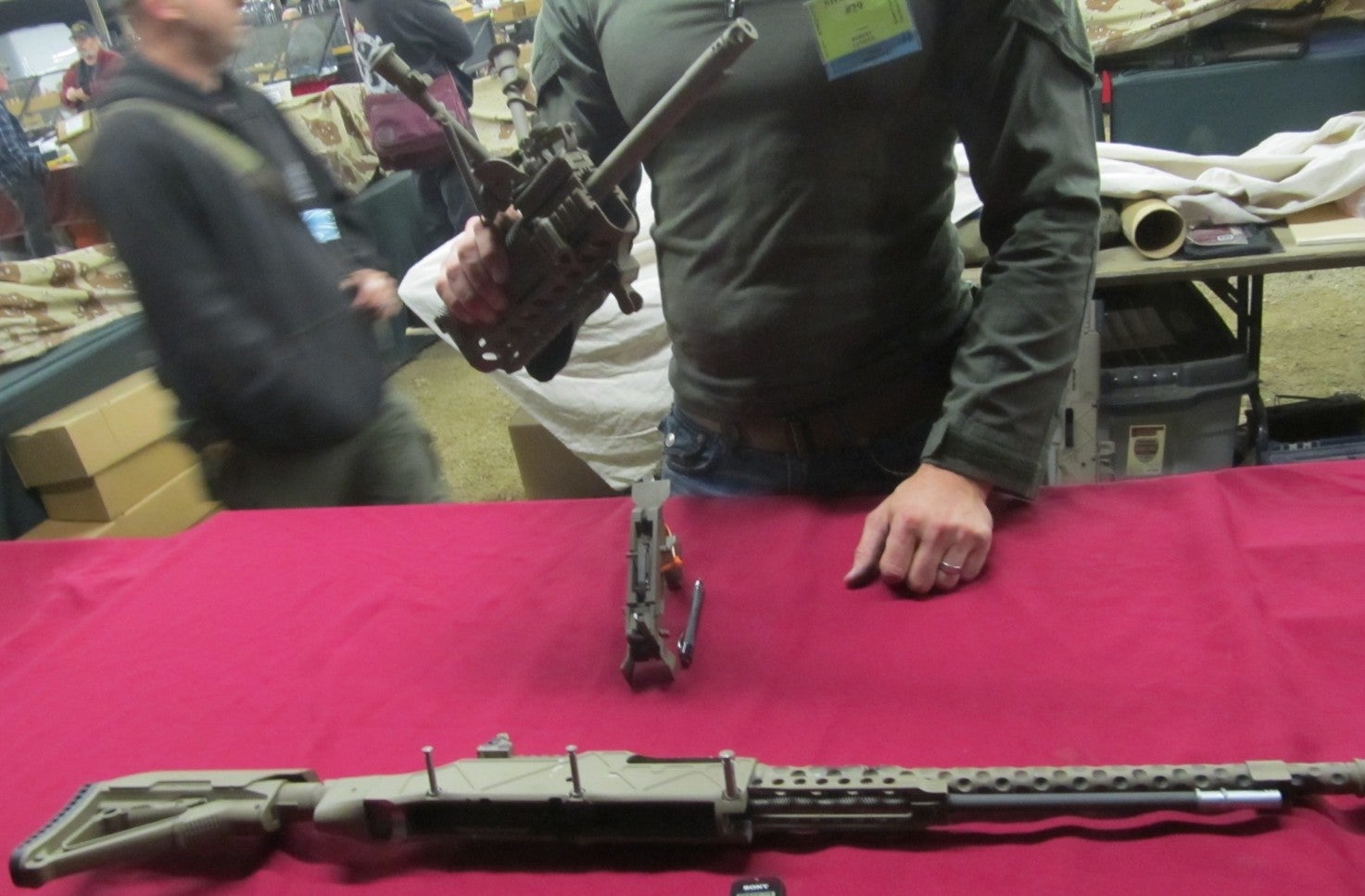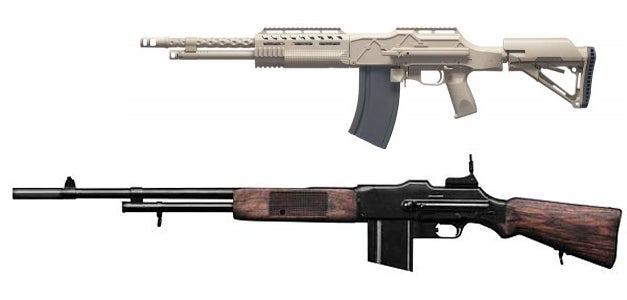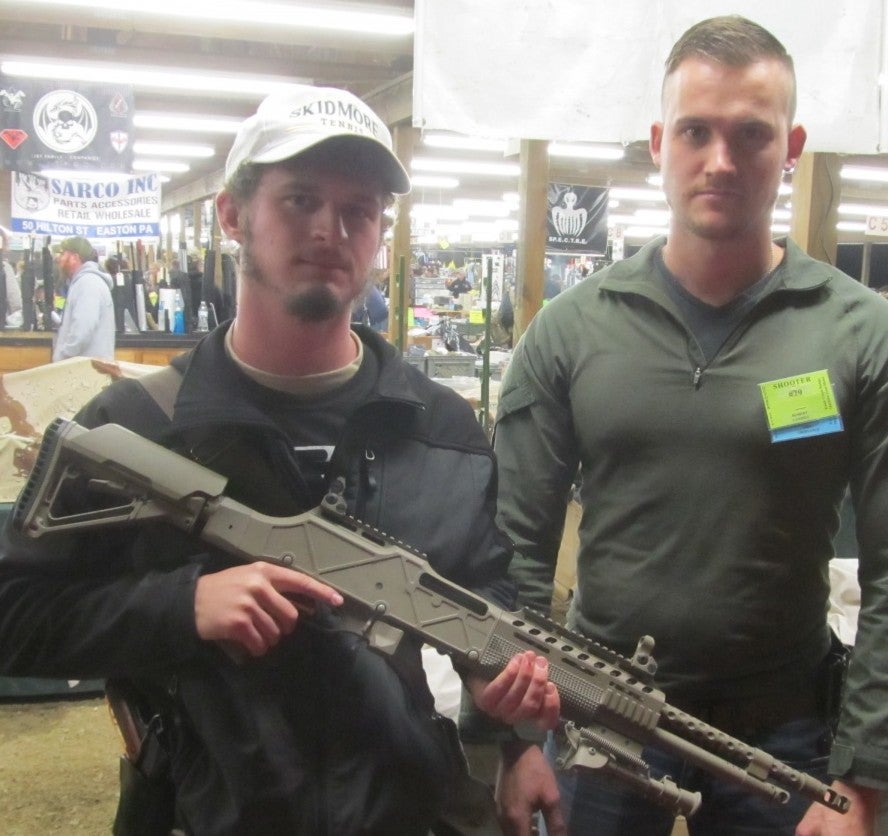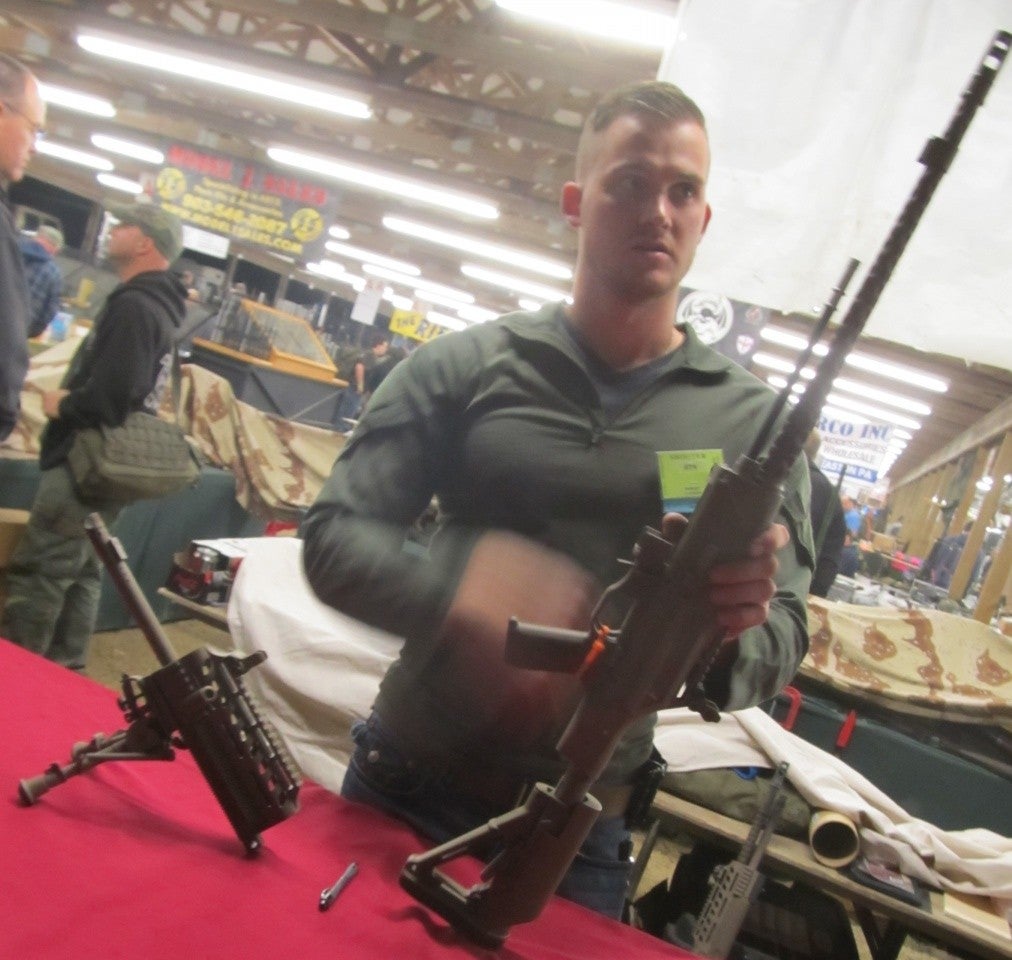During the fall Knob Creek Machine Gun Shoot, TFB got the opportunity to catch up with Robert Landies II of Ohio Ordnance Works Inc, and talked to him about his interesting new rifle, the HCAR (Heavy Counter Assault Rifle), an updated BAR for the modern era. He is the son of Robert Landies, the founder and current owner of Ohio Ordnance, who started the company in 1981 and specializes in buying/selling class three weapons as well as making their own line of semi auto versions of old designs, such as the M1918 BAR and M1919 light machine gun.
As firearms enthusiasts, we are always internally asking questions about our guns, why did the designer put this rivet here and not over there, why is the grip in this location and not this other location. Having a chance to actually sit down with the original designer of a weapon is truly eye opening as we can ask these questions to the source of the design. During the October 2014 Shoot, Ohio Ordnance brought their HCAR to the main firing line at Knob Creek. Here is a video of Landies on the line shooting it under different conditions.
The Firearm Blog- Apart from small arms, what is some of your previous background?
Robert W. Landies II- I was a Marine reservist out of a Youngstown, Ohio detachment, but recently just left the reserves. I was a Radio Operator but am planning on going back in as an officer.
TFB- So how has the HCAR been doing at the shoot?
Landies- It’s been pretty good, we brought some of our HCAR rifles out here as well as delivered some to a couple of our customers who were shooting it on the main line with us earlier today. We had some issues with the ammunition we were using but that’s because we shot the cheapest .30-06 we could find.
TFB- So MSRP is going at $4,699?
Landies- $4,500 is going to be standard for the gun and two magazines. We’ve got the first production run of 250 guns, of which we’ve sold over half of them. The full deal is with $4,700 and that’s with the gun, 4 magazines, a full case, ammunition, magazine pouches and a number of other accessories.
TFB- At that price range are you aiming the HCAR as more of a novelty product or is there a practical application?
Landies- We’re not really seeking out a certain customer base, there’s not really many guns like it, in .30-06. People ask me why didn’t I go to .308 and to that I say the system is proven in .30-06. A .308 would be a downgrade, we’ve got 40 percent more cartridge capacity in .30-06 than we do in .308. We’ve got more powder and more velocity, as well as more options out of the gun. There were two other guys who helped out with the specifics of the internal operations, it was all a collaborative project. But I really just started it to have another option on the market. Look at ARs and all the stuff people hang off of them and how much people put into it to customize it. The BAR is a classic system, I love it, I’ve grown up seeing it manufactured in our shop. So I’ve taken up revamping and revising it, to bring it into the 21st century. With the HCAR, I wanted it have usable rail space, a pistol grip, an easier trigger, and an easier magazine release. Everything you see on here is ideal for the modern shooter. You can also get custom serial numbers on it if you order in advance.
TFB- So the kind of people interested in this, they’re probably already BAR aficionados?
Landies- Partially it’s that, but it’s also something new that they can use. Like why do people buy ARs? Part of our marketing program we’ve got going on is you can use this gun to fill three roles, you can use it for close quarters because it’s short and light enough, it’s only 11 and three quarter pounds. If we’re looking at an AR in .308, most of those rifles are at around 11 pounds as well. Same thing with an M110. In addition to close quarters, you can also do intermediate ranges out to 300 meters and then long range as well. We’ve shot it out to 1400 yards and it did well. I wasn’t the one shooting it, I’ve shot it out to 773 yards with half a minute of angle.

The M1918A2 Browning Automatic Rifle. This version was used in World War Two as opposed to the original M1918 which was used at the tail end of World War One and in the interwar years. It was popular to take off the bipod as this added weight to the rifle. Image from World.guns.ru.
TFB- What has remained from the BAR that is present in the HCAR?
Landies- The receiver is the same as the semi auto only BARs that we have been making since 1996. I basically took that semi auto system, which is made to look like the original M1918 model. I took over a pound off from the receiver, about 27 percent of the old one. Upgraded it, put a rail on top. New take down pins, a whole new trigger housing group with the trigger set at 5 lbs that we designed in house, bolt hold open device, new magazine release, new safety selector.
TFB- Can this new rifle take the original 20 round BAR magazines?
Landies- Yes, it can. The only thing that won’t function is the bolt hold open device with original twenty round magazines. The bolt is actually designed to be pulled back, and will lock back on it’s own, even without a magazine inserted. So if you put an original 20 round magazine in, it wouldn’t hold open on an empty magazine.
TFB- Explain the theory behind the cuts in the barrel?
Landies- It’s partly for heat dissipation and it’s also for making the rifle lighter. It’s actually a patented design and reduces the weight, also increasing surface area so there’s more cooling and maintaining strength of the barrel.
TFB- What aftermarket parts are on the gun that you don’t make at the Ohio Ordnance facility?
Landies- We’ve got a Magpul buttstock, aftermarket AR buffer tube, and Troy sights. This allows customers to put whatever stock they want, a non adjustable PRS stock for example. We will be coming up with a 20 inch barrel version as opposed to this 16 inch barrel. The gas tube is also adjustable for suppressor use. The pistol grip is made by a molding company, molded out of carbon fiber reinforced polymer. The same company makes the forward handguard. We looked into using AR pistol grips for more versatility, keeping the grip steel would have put some extra weight on the gun. But looking at the types of adjustable AR grips out there, it doesn’t really change the overall handling that much. I kept it on the smaller side of thickness, so guys with smaller hands could wrap their fingers around it, but if you wanted to, you can put rubber sleeves over the grip to increase the size. But you can’t do that if it’s a large grip to begin with. It might look like there wasn’t alot of thought put into the grip, but in fact there was a good amount of consideration put into it. For example there’s a combination of 8 different grip concepts placed into that one, such as the geometry and dimensions of various rifle, pistol, and machine gun grips.
TFB- What made you go with these kinds of forward handguards, they’re very aggressive in texture?
Landies- Well today alot of shooters use gloves, especially in an LE/Military role for various reasons. So by going with this aggressive texture it allows the handguard to dig into the glove and have a firmer hold on the rifle. This is especially useful when it’s slippery or you get oil on it. I didn’t intend for it to have this type of grip in the beginning because the original BAR design just had checkering on it. But it turned out to work that way.
TFB- Can you talk about the M1913 forward rails on the gun?
Landies- I’m not at all a fan of the quad rail system that the market is full of today. I’ve always been looking for ways to cut it off or cover it up. That’s why I only put these three inch sections around it for attachment of the bipod or lights. I don’t think you need more than what I put on there. This goes with the top optic rail and that dip in the rail system. You can still put a night optic in front of whatever main optic you have on there. It also allows for a larger objective, something like a 56mm objective to be mounted on the rifle because that cut in the rails allows a larger objective to sit down in there. You can get low rings and still have it on there as opposed to having to get higher rings and bringing your head further off the rifle which would be the case if you had a full length top rail. If the scope is really an issue, then you can always take the back up sights off the rifle because if you’re using that large of a scope you probably have a very low need for backup sights anyways.
TFB- What kind of muzzle brake is the rifle shipping with?
Landies- It’s a Surefire brake, the same kind SOCCOM uses and we have on our M40A5s. It’s actually the best mounting system, as far as a higher caliber rifle barrel can go.

Landies showing the HCAR fully field stripped. Notice how the handguard comes off just like a H&K M27.
TFB- So what is with the ribs on both sides of the receiver?
Landies- They’re for strength, if you look at the circles on the receiver, those are internal rivets for the internal bolt rails. We’ve thinned out the receiver a little bit and those ribs are to maintain strength between the top and bottom of the receiver. That was how we took over a pound from the receiver alone. At the same time, we built in these other features such as the push-pull pins to take it apart.
TFB- How is the M1913 rail staked to the receiver? Because if there’s any wobble between the receiver and the rail, that could drive the whole scope off.
Landies- That rail is mounted in four different places, there’s a dovetail mount on either end of the rail. There’s two screws in the center of the rail that pull it down to the receiver. Those are also shoulder bolts.
TFB- Why is the rear portion of the rifle shaped so odd?
Landies- That rear part of the stock is the hydraulic buffer adapter. I took the original end of the receiver, and if you look you can see the angled portion of the stock. That is 8 degrees perpendicular of the receiver. The angle of the stock didn’t matter in the original BAR because the stock was so big and bulky so that Browning could fit the whole buffer system inside it. But if you imagine, what happens when you have force coming straight back at you? Going into physics, it’s going to force the barrel to rise. It didn’t really matter on the original BAR because it had a 24 inch barrel, heavy bipod, and most of the weight up front to keep the barrel from rising. If you were shooting it on fully automatic fire, you could muscle it up there and the gun would stay in place during fire. But being that the HCAR has a lightened and shortened barrel, a shooter doesn’t have all that weight to keep the gun down. That’s why I want the angle rear portion to help keep the gun down during recoil because I wanted a more linear system. Once you shoot the rifle, the recoil is forced directly back into your shoulder. Similar to an in line recoil system of an AR, although I’m not trying to model an AR I am looking for the best recoil management.
TFB- Can the barrel be taken off or is it fixed to the receiver?
Landies- It’s threaded in and factory mounted. If you need a new barrel, you’d have to send the gun back to us. Sure, people are going to figure out how to take it out on their own, but we don’t endorse that.
TFB- How does the rate of fire compare to the original BAR?
Landies- The original BAR was semi automatic and fully automatic. In the M1918A2, they had slow and fast settings for fully automatic. Around 450 rpm for slow and around 600 rpm for the fast setting. I haven’t done a PACT timer test on the HCAR, but you can easily get around 350 rounds per minute. You can rattle them off pretty quick.
TFB- What kind of inspiration from other designs have led you to the HCAR?
Landies- Not much, most of the inspiration comes with the aesthetics. As an engineer I like the aesthetics side more. The gun has to function above all. It has to be ideally designed, in that you could hand this to someone and they could figure out the operations of the gun on their own in a matter of minutes. If you pick it up and you know anything about guns, you can say, ‘Oh, here’s the charging handle, this is the safety, this is the bolt release”. I needed it to be intuitive, instead of having to really look for the various switches and operations of the rifle.
 Your Privacy Choices
Your Privacy Choices


